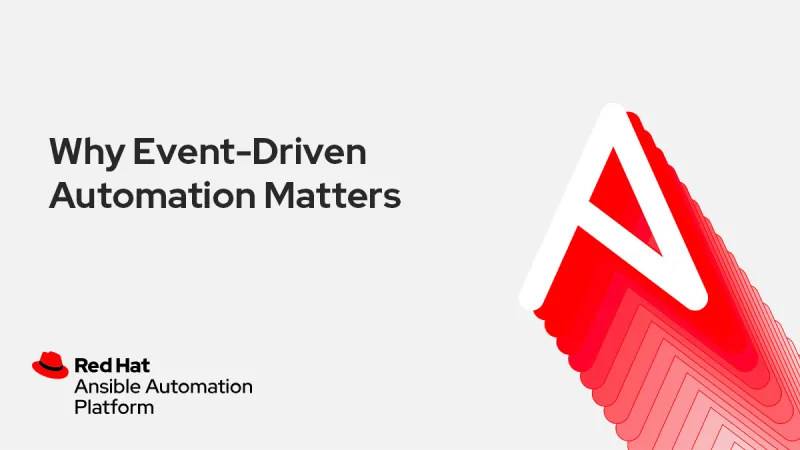
Life comes down to moments. These events are often how we define our achievements, successes, and failures throughout life. Just like our daily lives, IT organizations and teams can also have these defining moments, where you will often hear phrases like the "great database crash of '98." Many of these memorable IT moments occur from limiting ourselves to a reactive approach when it comes to managing our IT assets. This is where event-driven automation can help us move from reactive to proactive IT management – well before we have the next great issue or moment in our IT teams.
In an IT context, events come from monitoring or other tools to tell us when something needs attention. With this event data, we are able respond faster with automated tasks, resolving issues or enhancing observation where needed, often so we can identify and address festering issues before they are full blown problems. A byproduct of this means teams are now able to spend more time innovating, and are able to realize greater work-life balance because troubleshooting patterns and remediation approaches are automatically initiated based on an initial event in your environments.
Events on the Infrastructure
Consider the ubiquitous, laborious, and manual experience of remediating tickets submitted through IT service management systems. Automating from IT service management system events is one potent way to find savings in the costs of closing out trouble tickets. Historically, tickets require some level of manual touch, even if there is no system issue to resolve. And resolving system issues manually only increases the time and cost. Using event-driven automation to remediate the tickets and, even resolve or partially resolve the incidents themselves, not only helps you reduce your costs and better allocate your resources, it can also improve your customer experience. And your efficiencies can improve as your data grows, allowing you to automate a growing number of issues, and increasing complexity, depending on the ruleset you want to create.
In addition to resolving tickets, event-driven automation can also be used to automate compliance by checking and maintaining patch levels, and remediating and preventing drift. Using a file system watcher, file system changes can be a trigger for remediation. Not only can the remediation be helpful, but the resulting data can be evaluated to identify larger problems that may require manual intervention. On the security side, firewall changes could be used as a trigger for event-driven remediation.
Events on the Network
But there are also other areas where event-driven remediation could help you find surprising efficiencies and cost savings, like network automation. Going beyond automating device configuration or network fact collection, imagine the value of creating a self-scaling, self-healing network. An event based on a workload threshold within an environment could trigger automated network resource management, improving customer experience, as well as reducing the time and cost associated with manual scaling. When you can customize and scale how extensive and complex your automation is, you can increase efficiency over time, without sacrificing the ability to gather data and assess risk.
Events at the edge
Automation plays a key role in managing data and applications at the edge. As with the above use cases, event-driven automation can identify system changes in edge devices and remediate drift. You could also use triggers to deploy containers at the edge using systemd with Red Hat Enterprise Linux.
The future of events and automation
While there’s still a lot of room for innovation (applying machine learning, for example), much of the value lies in using event-driven automation to be more proactive in your IT operations and further reduce manual efforts.
In closing, there is a large amount of event data about your IT systems already in your environment. Why not use it to your advantage to make troubleshooting issues faster and easier or even resolving them before they grow into a moment? Get started by learning more about event-driven automation. Here are a few resources to help:
- Achieving speed and accuracy though event-driven automation
- Event-driven remediation with systemd and Red Hat Ansible Automation Platform
- Implementing an event driven architecture (AnsibleFest 2021)
- Check out these advanced automation session at AnsibleFest 2022
Also check out AnsibleFest 2022 in person in Chicago on October 18 and 19, 2022! Exciting news will be shared and you can check out additional event driven sessions.
Sull'autore
Altri risultati simili a questo
Data-driven automation with Red Hat Ansible Automation Platform
Ford's keyless strategy for managing 200+ Red Hat OpenShift clusters
Technically Speaking | Platform engineering for AI agents
Technically Speaking | Driving healthcare discoveries with AI
Ricerca per canale
Automazione
Novità sull'automazione IT di tecnologie, team e ambienti
Intelligenza artificiale
Aggiornamenti sulle piattaforme che consentono alle aziende di eseguire carichi di lavoro IA ovunque
Hybrid cloud open source
Scopri come affrontare il futuro in modo più agile grazie al cloud ibrido
Sicurezza
Le ultime novità sulle nostre soluzioni per ridurre i rischi nelle tecnologie e negli ambienti
Edge computing
Aggiornamenti sulle piattaforme che semplificano l'operatività edge
Infrastruttura
Le ultime novità sulla piattaforma Linux aziendale leader a livello mondiale
Applicazioni
Approfondimenti sulle nostre soluzioni alle sfide applicative più difficili
Virtualizzazione
Il futuro della virtualizzazione negli ambienti aziendali per i carichi di lavoro on premise o nel cloud
